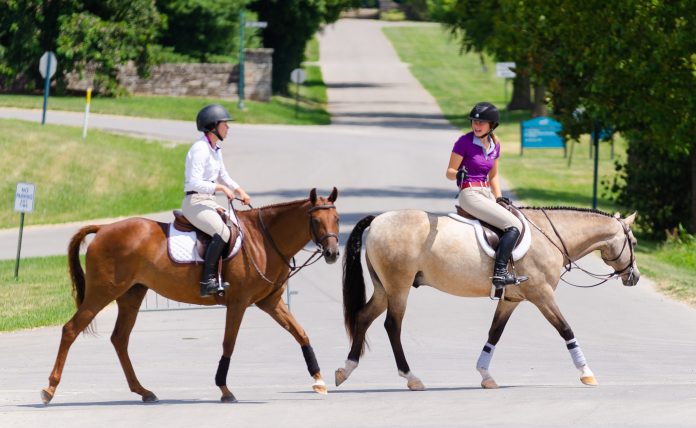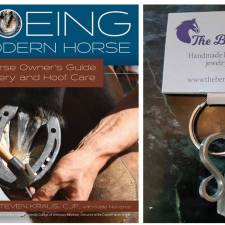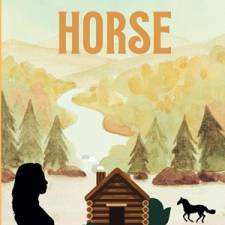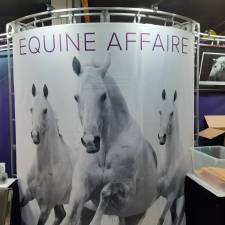
A Colorado Town Rises Up To Make Streets Safer For Equestrians
by Lee Foster
On December 2nd, careless driving turned deadly in a quiet Colorado equestrian neighborhood. A local schoolteacher and her horse were on their way to ride the trails at a park near their barn when they stopped at a stop sign, looked both ways, and proceeded to cross an intersection they had ridden through hundreds of times over their years of riding the neighborhood together.
Halfway through the intersection, the rider saw a car approaching the four-way stop much too fast. She screamed for the driver to stop as she urged her horse out of the car’s path. The driver, she would explain to the local news later, did not even look up from his lap.
He smashed into her horse, shattering his front legs on impact and sending her flying onto the hood and windshield of the car. When law enforcement arrived on scene, the shaken rider said she was unhurt and stayed with her companion until he was euthanized in the street fifteen minutes after the crash.
The driver was sent home with a ticket for running a stop sign.
A Tight-Knit Community
Nestled between the foothills and the plains, the laid-back town of Arvada, Colorado might not seem like a hotbed of equestrian activity – blocks of condominiums and strip malls have largely replaced the historic barns and pastures that once defined its landscape. But the equestrian community hasn’t gone anywhere.
Instead, it’s adapted to the shut-down boarding barns and increased housing development. Town-broke pleasure horses can be found in drive-thrus and at tavern hitching racks, while A Circuit champions go about their workouts alongside youth drill team and gymkhana horses, tucked behind privacy fences and long driveways. Keep your eyes peeled and you might even spy a field hunter conditioning in the grass strips along the parkway.
As the traditional infrastructure for horsekeeping disappears from the area, horse folk of all backgrounds have become increasingly resourceful and reliant on community resources. People board in friends’ pastures and ride in dilapidated public arenas where the footing quality depends on neighborhood organizers.
Unofficial routes through neighborhoods are established and negotiated with neighbors in order to access riding areas. Sometimes, conditioning is just done by walking around the block. As jokes about invading local golf courses become less tongue-in-cheek, horse owners have come to realize that self-reliance in the local horse industry is becoming a thing of the past.
Tragedy Strikes Too Close to Home
When Griffin the off-track Thoroughbred was struck by a car, the outcry was immediate and vast. The collision occurred on a busy residential street near the school where the rider teaches, and dozens bore witness to the tragedy as the rider’s worst nightmare played out before her eyes. Within hours, news of the crash had spread from the northern reaches of Colorado to the remote communities in the Rocky Mountains.
The local equestrians’ anger and grief were palpable, and cries for law enforcement to do more to punish the driver rose up all over social media. Soon, a post was circulating on Facebook with instructions for how to write to Colorado State Patrol as well as the state congresswomen representing the district where Griffin died.
Dozens of people raised their voices and spoke up on behalf of the crash victim and her horse, demanding a safer city and a safer county for equestrians as the area becomes more urbanized. People contacted the media, and the outrage grew as two TV stations aired stories about the devastating wreck.
From Social Media Rage Comes Real Life Hope for Change
Within days of the launch of the email campaign to the state congresswomen, the district’s state representative reached out by phone to one of the organizers, expressing her heartbreak at the senseless loss and her firm resolve to help bring change. At the same time, the scheduled monthly meeting of the Arvada Area Horsemen’s Association was opened to the aggrieved equestrian public.
The meeting’s organizers scrapped the original agenda and put together a PowerPoint presentation on how the local horsemen’s associations and horse councils are already working toward a horse-friendly development plan for the county.
Thanks to a grassroots Facebook campaign that reached thousands without boosting a single post, the December 11th meeting’s attendance was standing room only with overflow tuning in via Zoom.
Over two hundred equestrians, representing every corner of the state, turned out to discuss positive changes that need to be made in the community. The state congressional representative was there with her six month old baby. Accompanying her was a county commissioner as well as a representative from the county planning and zoning commission.
Over the course of two hours, the gathered crowd discussed an equestrian-friendly master plan for the county’s infrastructure; statewide legislation to protect equestrians on public roadways; and steps individual equestrians can take to protect themselves when hacking out on the street. The overall takeaway from the meeting was that equestrians, when organized, are a powerful force for community change.
The main obstacle between equestrians and a safe community is the difficulty of organization and community participation in local government. Fortunately for the Arvada community, the outcry surrounding Griffin’s death has united equestrians around a common goal of safer infrastructure and enhanced legal protections for horses on the road.
A Fight for Change is Just Beginning
Many equestrians are aware of local horsemen’s associations and horse councils, which are typically nonprofit organizations geared toward providing group riding opportunities as well as giving the equestrian community a voice at the political table. The Arvada meeting boasted representatives from the Colorado Horse Council, Community Equestrian Arvada, the Arvada Area Horsemen’s Association, and the Jefferson County Horse Council.
Attendees were urged to join at least one of these organizations and keep the organizational momentum going. Changing laws and infrastructure policies is a noble goal that requires a lot of dedicated and at times tedious work on behalf of the citizens who want that change.
The need for substantial fundraising was also brought up, since infrastructural changes to make the community safer for horses require a significant amount of professional services just to research as well as permits, materials, and labor in order to implement them.
The prospect of raising enough money to buy a going grand prix horse may be daunting to some in the local community, but the reality is that the horse community is well-connected and generally affluent compared to other communities who have successfully enacted change in their towns and counties.
As the Arvada community processes its shock and grief over the unconscionable loss of our friend’s equine partner, community members are taking comfort and inspiration from the messages relayed at the December 11th town hall meeting. Even better, they are mobilizing under the banners of their local horsemen’s associations to bring about crucial protections for equestrians in a rapidly urbanizing neighborhood.
Although the #JusticeForGriffin outcry is centered in Colorado, riders within the state have expressed hope that their efforts will be seen and mirrored throughout the nation as equestrians strive to preserve their way of life in the modern world.
Lee Foster is a lifelong equestrian hailing from rural Colorado. Raised by a rodeo cowboy in a Pony Club family, he has a soft spot for quirky grade horses and off-track Thoroughbreds with a certain gleam in their eye. When he is not cleaning his tack for the hunt or malingering in the local consignment shop, Lee can generally be found hacking around town or teaching lower-level dressage to local eager youths.
This article originally appeared on The Plaid Horse and is published here with permission.
There are many more interesting articles in our section on Recreation & Lifestyle.












